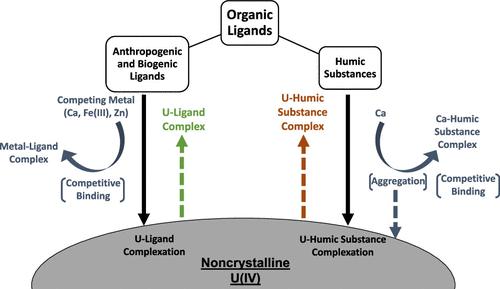当前位置:
X-MOL 学术
›
Environ. Sci. Technol.
›
论文详情
Our official English website, www.x-mol.net, welcomes your
feedback! (Note: you will need to create a separate account there.)
Effect of Competing Metals and Humic Substances on Uranium Mobilization from Noncrystalline U(IV) Induced by Anthropogenic and Biogenic Ligands
Environmental Science & Technology ( IF 10.8 ) Pub Date : 2023-10-11 , DOI: 10.1021/acs.est.3c01705 Kyle J Chardi 1 , Walter D C Schenkeveld 2 , Naresh Kumar 2 , Daniel E Giammar 3 , Stephan M Kraemer 1
Environmental Science & Technology ( IF 10.8 ) Pub Date : 2023-10-11 , DOI: 10.1021/acs.est.3c01705 Kyle J Chardi 1 , Walter D C Schenkeveld 2 , Naresh Kumar 2 , Daniel E Giammar 3 , Stephan M Kraemer 1
Affiliation

|
Anthropogenic and biogenic ligands may mobilize uranium (U) from tetravalent U (U(IV)) phases in the subsurface, especially from labile noncrystalline U(IV). The rate and extent of U(IV) mobilization are affected by geochemical processes. Competing metals and humic substances may play a decisive role in U mobilization by anthropogenic and biogenic ligands. A structurally diverse set of anthropogenic and biogenic ligands was selected for assessing the effect of the aforementioned processes on U mobilization from noncrystalline U(IV), including 2,6-pyridinedicarboxylic acid (DPA), citrate, N,N′-di(2-hydroxybenzyl)ethylene-diamine-N,N′-diacetic acid (HBED), and desferrioxamine B (DFOB). All experiments were performed under anoxic conditions at pH 7.0. The effect of competing metals (Ca, Fe(III), and Zn) on ligand-induced U mobilization depended on the particular metal–ligand combination ranging from nearly complete U mobilization inhibition (e.g., Ca-citrate) to no apparent inhibitory effects or acceleration of U mobilization (e.g., Fe(III)-citrate). Humic substances (Suwannee River humic acid and fulvic acid) were tested across a range of concentrations either separately or combined with the aforementioned ligands. Humic substances alone mobilized appreciable U and also enhanced U mobilization in the presence of anthropogenic or biogenic ligands. These findings illustrate the complex influence of competing metals and humic substances on U mobilization by anthropogenic and biogenic ligands in the environment.
中文翻译:

竞争金属和腐殖质对人为和生物配体诱导的非晶 U(IV) 铀动员的影响
人为和生物配体可以从地下四价 U (U(IV)) 相中动员铀 (U),特别是从不稳定的非晶 U(IV) 中。U(IV) 动员的速率和程度受地球化学过程的影响。竞争性金属和腐殖质可能在人为和生物配体的 U 动员中发挥决定性作用。选择了一组结构多样的人为和生物配体来评估上述过程对非晶 U(IV) 动员 U 的影响,包括 2,6-吡啶二甲酸 (DPA)、柠檬酸盐、N , N '-di(2 -羟基苄基)乙二胺-N , N'-二乙酸(HBED)和去铁胺B(DFOB)。所有实验均在 pH 7.0 的缺氧条件下进行。竞争性金属(Ca、Fe(III) 和 Zn)对配体诱导的 U 动员的影响取决于特定的金属-配体组合,范围从几乎完全的 U 动员抑制(例如柠檬酸钙)到没有明显的抑制作用或加速尿素动员(例如,柠檬酸铁(III))。腐殖质(苏万尼河腐殖酸和富里酸)在一定浓度范围内进行了测试,可以单独使用,也可以与上述配体结合使用。单独的腐殖质可动员大量的尿素,并且在人为或生物配体存在的情况下也可增强尿素的动员。这些发现说明了竞争性金属和腐殖质对环境中人为和生物配体对 U 动员的复杂影响。
更新日期:2023-10-11
中文翻译:

竞争金属和腐殖质对人为和生物配体诱导的非晶 U(IV) 铀动员的影响
人为和生物配体可以从地下四价 U (U(IV)) 相中动员铀 (U),特别是从不稳定的非晶 U(IV) 中。U(IV) 动员的速率和程度受地球化学过程的影响。竞争性金属和腐殖质可能在人为和生物配体的 U 动员中发挥决定性作用。选择了一组结构多样的人为和生物配体来评估上述过程对非晶 U(IV) 动员 U 的影响,包括 2,6-吡啶二甲酸 (DPA)、柠檬酸盐、N , N '-di(2 -羟基苄基)乙二胺-N , N'-二乙酸(HBED)和去铁胺B(DFOB)。所有实验均在 pH 7.0 的缺氧条件下进行。竞争性金属(Ca、Fe(III) 和 Zn)对配体诱导的 U 动员的影响取决于特定的金属-配体组合,范围从几乎完全的 U 动员抑制(例如柠檬酸钙)到没有明显的抑制作用或加速尿素动员(例如,柠檬酸铁(III))。腐殖质(苏万尼河腐殖酸和富里酸)在一定浓度范围内进行了测试,可以单独使用,也可以与上述配体结合使用。单独的腐殖质可动员大量的尿素,并且在人为或生物配体存在的情况下也可增强尿素的动员。这些发现说明了竞争性金属和腐殖质对环境中人为和生物配体对 U 动员的复杂影响。


















































 京公网安备 11010802027423号
京公网安备 11010802027423号